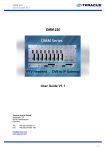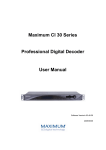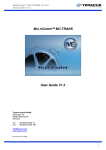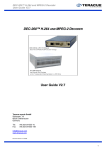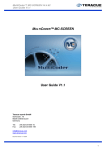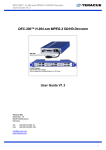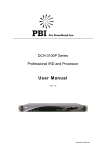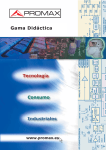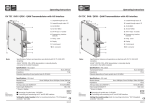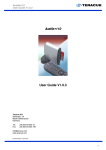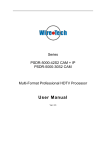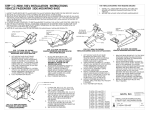Download DMM-S User Guide V1.1
Transcript
DMM-Series User Guide V1.2 DMM-SERIES User Guide V1.1 Teracue eyevis GmbH Schlossstr. 18 85235 Odelzhausen Germany Tel: Fax: +49 (0)8134-555-10 +49 (0)8134-555-199 [email protected] www.teracue.com Document Version 1.2/141113 1 DMM-Series User Guide V1.2 2 DMM-Series User Guide V1.2 COPYRIGHT This document may not be reproduced in any form, in whole or in part, without the prior permission of Teracue eyevis GmbH. Copyright © 2014 by Teracue eyevis GmbH, all rights reserved. DISCLAIMER This publication supersedes all previous publications. Information and specification in this documentation is subject to change without notice. Please make sure you have the latest document version. Documents are located at: www.teracue.com/support If you find some points in this document unclear then please let us know, so we can improve this documentation. Thank you! Mail to: [email protected] All information within this document is confidential to Teracue eyevis GmbH costumers and should not be copied or distributed to non Teracue eyevis GmbH customers. TRADEMARKS All Teracue products and all of its components are registered trademarks licensed to Teracue eyevis GmbH. All other logos and trademarks both marked and not, may be trademarks or registered trademarks and therefore property of their respective owners. 3 DMM-Series User Guide V1.2 I. Information about the manual This manual is designed to help administrators and users to install the DMM-Series on their computer. If you received this publication as a PDF, then it's a good idea to print it out for future reference. It is best to use this user guide directly in front of your computer, by doing so you try out everything at once. .!. Important features are marked by this sign. 4 DMM-Series User Guide V1.2 II. 1. Content OVERVIEW ...................................................................................................................................... 6 1.1 1.2 1.3 1.4 1.5 1.6 2. CONTROL WITH DISPLAY AND KEYPAD .................................................................................... 8 2.1 2.2 3. CHARACTERISTICS ..................................................................................................................... 6 MAIN FEATURE .......................................................................................................................... 6 DMM-100 MAIN CHASSIS .......................................................................................................... 6 DMM-100 CU HANDHELD PROGRAMMER UNIT ........................................................................... 6 DMM-140 SERIES PROFESSIONAL MPEG-2 SD IRD AND PROCESSOR MODULE ......................... 7 DMM-150 SERIES PROFESSIONAL MULTI-FORMAT HD/SD IRD AND PROCESSOR MODULE .......... 7 DMM-150 SERIES ..................................................................................................................... 8 DMM-140 SERIES ................................................................................................................... 11 CONTROL WITH WEB SERVER .................................................................................................. 14 3.1 DMM-150 DECODER MODULE ................................................................................................. 14 3.1.1 Status Menu....................................................................................................................... 14 3.1.2 Tuner ................................................................................................................................. 15 3.1.3 CI ....................................................................................................................................... 16 3.1.4 Decoder ............................................................................................................................. 17 3.1.4.1 Audio .......................................................................................................................... 17 3.1.4.2 Video .......................................................................................................................... 18 3.1.4.3 Decoder Play ............................................................................................................. 19 3.1.5 Output ................................................................................................................................ 20 3.1.6 BISS ................................................................................................................................... 20 3.1.7 MUX ................................................................................................................................... 21 3.1.8 IP Out ................................................................................................................................. 21 3.1.9 IP In ................................................................................................................................... 24 3.1.10 Backup ........................................................................................................................... 25 3.1.11 System ........................................................................................................................... 26 3.1.11.1 Device ....................................................................................................................... 26 3.1.11.2 Version...................................................................................................................... 26 3.1.11.3 Network..................................................................................................................... 27 3.2 DMM-140 DECODER MODULE ................................................................................................. 28 3.2.1 Status Menu....................................................................................................................... 28 3.2.2 Input Menu ......................................................................................................................... 29 3.2.3 Output Menu ...................................................................................................................... 29 3.2.3.1 ASI Output ................................................................................................................. 29 3.2.3.2 ASI2/SDI .................................................................................................................... 30 3.2.3.3 Decoder Play ............................................................................................................. 30 3.2.3.4 Decoder Config .......................................................................................................... 31 3.2.4 CI ....................................................................................................................................... 32 3.2.5 IP Out ................................................................................................................................. 33 3.2.6 IP In ................................................................................................................................... 36 3.2.7 System ............................................................................................................................... 37 4. TECHNICAL SPECIFICATION ...................................................................................................... 39 4.1 4.2 5. DMM-140 SERIES ................................................................................................................... 39 DMM-150 SERIES ................................................................................................................... 41 FAQ ................................................................................................................................................ 43 5.1 W HAT IS A “GOOD” INPUT SIGNAL FOR SATELLITE RECEPTION?.................................................... 43 6. STATEMENT OF CONFORMITY DMM-140-SERIES ................................................................... 44 7. STATEMENT OF CONFORMITY DMM-150-SERIES ................................................................... 45 5 DMM-Series User Guide V1.2 1. Overview 1.1 Characteristics DMM-Series is a compact modular digital TV head end that includes professional MPEG-2 and H.264 SD/HD IRD, MPEG-2 and H.264 SD/HD, Re-Multiplexer, QAM/COFDM Trans-Modulator, DVB Scrambler. Within 19” 4RU chassis, it provides 8 slots for any type of modules with redundant power supply. Also available 19” 1RU chassis for 2 slots with single power supply. With flexible solution and the high density, DMM-100 offers operators the advanced head end architectures in the marketplace for delivering analog and digital broadcast services to their subscribers. Coming with more new modules, DMM-100 is most suitable for future multiple network architectures: streaming and multiplexing of digital content over IP based networks and conversion of digital content for analog networks. 1.2 Main Feature DVB-S2/S, DVB-S, DVB-C, DVB-T2/T IRD modules with CI DVB-S/S2T/T2 to DVB-C QAM and DVB-T COFDM trans-modulator module 8 Way re-multiplexer module DVB Simulcrypt, BISS-1, BISS-E scrambler module Rich interface with ASI, IP, SDI, YPbPr, CVBS, XLR Web, SNMP Remote Control or handheld programmer unit local control 4RU 19” chassis compact modular design, supporting up to 8 modules with redundant power supply. 1RU 19” chassis compact modular design, supporting up to 2 modules with single power supply Functional module hot-swappable Intelligent cooling system Stand alone function of each module Cost-saving by backward compatible with new modules On site software update through IP 1.3 DMM-100 Main Chassis Standard 19” 4RU chassis with 8 slots for functional modules and 2 slots for power supplies Hot-swappable power supply unit Intelligent cooling system Wall mounted or Rack mounted Backward compatible with new modules Power Supply: AC 100V-260V, 50-60Hz Optional Build-in IP Switch 19” 1RU chassis with 2 slots and single power supply Dimension: L: 40,3 cm, W: 48,3 cm, H: 17,5 cm 1.4 DMM-100 CU Handheld Programmer Unit 2 x 20 LCD display screen and 6-key keypad No external power or battery needed Easy and quick on site system configuration without PC Backward compatible with new modules Dimension: L: 17,0 cm, W: 7,5 cm, H: 2,1 cm 6 DMM-Series User Guide V1.2 1.5 DMM-140 Series Professional MPEG-2 SD IRD and Processor Module Multiple inputs DVB-S2/S/C/T, TS/IP and ASI SD MPEG-2 MP@ML digital video decoding Flexible built-in re-multiplexing between ASI, Tuner and TS/IP Inputs 2x DVB-CI slots, multi programs, BISS-1 and BISS-E decryption Dynamic PMT detection and automatic updating UDP, RTP Multicast / Unicast IP output, supports up to 32 independent channels PCM audio embedded in SDI output Remote control and supervision by SNMP, HTTP WEB and proprietary HDMS software RSSI, received Eb/No & BER monitoring On Site software update through IP 1.6 DMM-150 Series Professional Multi-format HD/SD IRD and Processor Module Multiple inputs DVB-T2/S2/S/C/T/T2, TS/IP and ASI Redundant inputs between tuner, ASI and TS/IP SD/HD MPEG-2 and H.264 digital video decoding Digital audio decoding and loop through via SDI, HDMI and AES-EBU Multiple analog and digital outputs, ASI, CVBS, YPbPr, HDMI, SD/HD-SDI, TS/IP Flexible re-multiplexing between 2xASI, tuner and TS/IP Inputs 2x DVB-CI slots, multi programs, BISS 1 and BISS E decryption Dynamic PMT detection and automatic updating Support VBI TELETEXT, EBU/ DVB subtitle, closed caption UDP/RTP & Unicast/Multicast SPTS and MPTS over IP I/O Remote control and supervision by SNMP, HTTP WEB and proprietary HDMS software PCM audio embedded in SDI output or PCM audio over HDMI PCM output on two AES/EBU output ports On Site software update through IP RSSI, received Eb/No & BER monitoring 7 DMM-Series User Guide V1.2 2. Control with Display and Keypad 2.1 DMM-150 Series Main-Menu Sub-Menu Status DVB-S2 QAM COFDM Inputs RSSI Ethernet Description ASI: Display ASI input status TUNER: Display tuner input status IP IN: Display IP input status LNB Frequency: Input LNB frequency Satellite Frequency: Input downstream frequency of satellite Symbol Rate: Input symbol rate of satellite LNB Voltage: Off/13V/18 V LNB 22KHz: 22KHz or Off. DISQEC: Port A/Port B/Port C/Port D/DiSEQC OFF PLS Gold Code: 0~5000 Frequency Offset High: 5000KHz Frequency Offset Low: -5000KHz Constellation: 16/32/64/128/256QAM/64B/256B Frequency: Enter the frequency of the QAM signal in MHz. Symbol Rate: Edit the symbol rate to the proper value in kBaud. Frequency: Input terrestrial frequency. Bandwidth: select bandwidth from 6MHz, 7 MHz and 8 MHz. Tuner Status: Display tuner status Strength Display: Display the strength of tuner signal Stream IP Addr: 1.0.0.1~223.255.255.254 Stream Netmask: 1.0.0.1~223.255.255.254 and 0.0.0.0 Stream Gateway: 1.0.0.1~223.255.255.254 and 224.0.0.0~239.255.255.255 Stream Mac Address: Display MAC address Multicast IP Addr: Enter the IP address of the multicast stream for the transport stream over IP. Multicast UDP Port: Enter the UDP port number of the TS over IP stream. Protocol: UDP/RTP. Output Smoothing: Auto: the bit rate is variable. Disable: the unit let the TS pass by. Fixed Rate: the bit rate is fixed. TS Bit Rate: sets the bit rate of the TS which comes from the TS/IP input. The setting is only valid when the output smoothing is configured as Fixed Rate. 8 DMM-Series User Guide V1.2 Main-Menu Sub-Menu BISS Menu CI Decoder Outputs ASI1/2 SDI Mux Description Biss Mode: Set Biss mode, can select ‘OFF’, ‘Biss E’ or ‘Biss 1’ Biss 1 Setup: Set Biss 1 (password is required) Biss E Setup: Set Biss E (ID number and password are required) Biss Source: Tuner/ASI Input CI Source: MUX TS/Tuner/ASI Input Setup: Select TS CAM Name: Display CAM name of CI Slot1 and Slot2 Status: Show Status Source: CI De-encrypted/TUNER/ASI Input/Mux TS Program: Select programs. Video Video Standard: Select from Auto/1920x1080i 30/1920x1080i 29.97/1920x1080i 25/1280x720p 60/1280x720p 59.97/1280x720p 50/720x480p 59.94/720x480p 60/720x576p 50/720x576p 25/720x480i 29.97/720x576i 25 Screen: Select from Auto, 4:3 Full, 4:3 Letterbox, 16:9 Letterbox or 16:9 Full. DVB subtitle language: Choose DVB Subtitle language. EBU subtitle language: Choose EBU Subtitle language. Subtitle Priority: Select from DVB First or EBU First. Fail Mode: Select from Black Screen, No Sync and Still Picture. VBI Mode: Disable/Enable. VBI option only controls Closed – Caption over CVBS. To activate the CC over CVBS, enable the VBI option. Close Caption: Off/On. Controls both CC on CVBS and SDI. CVBS Sub PAL: select PAL mode, including PALB/D/G/H/I, PAL-N, PAL-N_C and SECAM. CVBS Sub NTSC: select NTSC Mode, including NTSC-M, NTSC-M_J, NTSC-M_443 and PAL-M. Note: the sub-menus VBI Mode, CVBS Sub PAL and CVBS Sub NTSC will only show up when the Closed Caption option is on. Audio Audio Level: 0~99. Audio Mode: select Stereo, Left, Right or Mono for soundtracks. Audio Priority: select the priority of the audio. Mode: select from Manual Selection and First Service. First Service means to select the program no. automatically, normally the first program in the TS. Manual Selection means to select the program manually. ASI1/2 Source: CI De-encrypted/TUNER/ASI Input/Mux TS Embedded Audios: On and Off. Closed Caption Mode: select from SMPTE 708, SMPTE 608, Line 21, and Auto. The mode of closed caption needs to be selected based on the video resolution. SMPTE 708 and SMPTE 608 are more suitable for HD video; SMPTE 608 and Line 21 are for SD. When select Auto, the unit will choose SMPTE 608 for HD video, and Line 21 for SD video. Note: Before doing the setup, be sure to enable the Closed Caption switch in the menu Decoder- Video. Mux Switch: On/Off Bit Rate: should be set to a specified value that doesn’t exceed the max physical limit of the output medium. For example, to deliver the multiplexed TS to an 8MHz DVB 256QAM modulator, it should not exceed 55000Kb/s, otherwise overflow occurs. 9 DMM-Series User Guide V1.2 Ethernet Backup Local Setup Trap IP Addr Unit Name Properties Factory Setting Optional Function HTTP Login TS ID: 1~65535 Program List: Select program. Output Bit Rate: Display Output bit rate Stream IP Addr: 1.0.0.1~223.255.255.254 Stream Netmask: 1.0.0.1~223.255.255.254 and 0.0.0.0 Stream Gateway: 1.0.0.1~223.255.255.254 and 224.0.0.0~239.255.255.255 Stream Mac address: Display factory-Set Mac addresses Gateway Mac address: Edit Gateway Mac address Multicast IP Addr: Enter the IP address of the Multicast Stream for the transport Stream over IP. Multicast UDP Port: Enter the UDP Port number of the TS over IP stream. Protocol: UDP/RTP TS Pkts Per UDP: 1~7 Time to live: 1~255 Type Of Service: Min Delay/Max Reliability/Max Throughput/Min Monetary Cost/Normal Source: Tuner/ASI input/Mux TS/CI De-encrypted Mode: IPTV/DVB Uni-/Multicast Setup Max Channels: 1~32 Channel 0~31 Switch: On/Off. Enable or disable the channel. Multicast IP Address: 224.0.0.0 ~ 239.255.255.255 *(When using Unicast, the Multicast IP Address should be set as the IP address of the receiving device.) Multicast UDP Port: 1~65535 Target MAC Address: Edit Target MAC Address Program List: Select program Main channel: ASI/Tuner. Backup channel: ASI/Tuner. Main CH Unlock Time: set Main CH Unlock Time, ranging from 0 to 59 seconds. When signal of the main channel remains the disconnected status over this value, the unit will switch to the backup channel automatically. Main CH Recover Time: set Main CH Recover Time, ranging from 0 to 59 seconds. When the signal of the main channel recovers and remains stable over this value, the unit will switch back to the main channel. IP Address: 1.0.0.1~223.255.255.254 Netmask: 1.0.0.1~223.255.255.254 and 0.0.0.0 Gateway: 1.0.0.1~223.255.255.254 and 224.0.0.0~239.255.255.255 MAC Address: Display MAC Address Trap IP Addr Unit Name Main Version Linux OS Version ARM S/W Version Decoder Version FPGA Version TS/IP Out NIOS TS/IP Out FPGA Enter: Yes, Exit: No External Board Type: 100M Single In/100M Single Out/No Exist Mux Function: Enable/Disable Filter Function: Select from Disable/Filter/Mux. Modify the username and password for the WEB management. 10 DMM-Series User Guide V1.2 2.2 DMM-140 Series Main-Menu Sub-Menu Status QPSK COFDM QAM RSSI Inputs Ethernet Status CI Decoder Description ASI: Display ASI input status TUNER: Display tuner input status IP IN: Display IP input status LNB Local Oscillator (L.O.) Freq: enter the frequency of the LNB in MHz. Satellite Freq: edit the satellite down link frequency in MHz. The IF frequency will be calculated automatically. Symbol Rate: enter the QPSK symbol rate. LNB Voltage: Off/13 V/18 V LNB 22KHz: On/Off DiSEQC: Port A/Port B/Port C/Port D/DiSEQC OFF Frequency: enter the proper frequency of the COFDM signal in MHz. Bandwidth: 6/7/8MHz Constellation: 16/32/64/128/256QAM/64B/256B Frequency: enter the frequency of the QAM signal in MHz. Symbol Rate: edit the symbol rate to the proper value in kBaud. Tuner Status: Display tuner status Strength Display: Display the strength of tuner signal Stream IP Addr: 1.0.0.1~223.255.255.254 Stream Netmask: 1.0.0.1~223.255.255.254 and 0.0.0.0 Stream Gateway: 1.0.0.1~223.255.255.254 and 224.0.0.0~239.255.255.255 Stream Mac Address: Display MAC address Multicast IP Addr: Enter the IP address of the multicast stream for the transport stream over IP. Multicast UDP Port: Enter the UDP port number of the TS over IP stream. Protocol: UDP/RTP. Output Smoothing: Auto: the bit rate is variable. Disable: the unit let the TS pass by. Fixed Rate: the bit rate is fixed. TS Bit Rate: 1~38000Kbps. The setting is only valid when the output smoothing is configured as Fixed Rate. Decoder: Press <Enter> to enter the alarm status page. CI: Display status for Slot1 and Slot2 Ethernet: Display Ethernet Status CI Source: MUX TS/Tuner/ASI Input/IP In Setup: Select TS Program: Select program Video Standard: Auto/SECAM/NTSC/PAL Screen: Auto/4: 3 Full/16: 9 Full/4: 3 Letterbox. DVB Subtitle Lang: select the language of DVB Subtitle. EBU Subtitle Lang: select the language of EBU Subtitle. Subtitle Priority: choose whether DVB or EBU should be first. Fail Mode: Black Screen/No Sync/Still Picture Close Caption: Select ‘OFF’ will turn off the caption and select ‘ON’ will turn on the caption. VBI Mode: Select ‘DISABLE’ will disable the VBI mode and select ‘ENABLE’ will enable the VBI mode. Audio: Audio Level: 0~99. Audio Mode: Stereo/Left/Right/Mono Audio Language: select the language of the audio. 11 DMM-Series User Guide V1.2 ASI ASI2/SDI Mux Filter Ethernet Biss: It includes Biss Mode, Biss 1 Setup and Biss E Setup Biss Mode: Set Biss mode, can select ‘OFF’, ‘Biss E’ or ‘Biss 1’ Biss 1 Setup: set Biss 1 (password is required) Biss E Setup: set Biss E (ID number and password are required) ASI Source: CI De-encrypted/TUNER/ASI Input/Mux TS ASI Package Length: 188/Bypass Select from ASI2 and SDI Mux Switch: On/Off Bit Rate: should be set to a specified value that doesn’t exceed the max physical limit of the output medium. For example, to deliver the multiplexed TS to an 8MHz DVB 256QAM modulator, it should not exceed 55000Kb/s, otherwise overflow occurs. TS ID: 1~65535 Program List: Select program. Output Bit Rate: Display Output bit rate Filter Switch: On/Off. To activate the filter function, you should turn on this filter functional block in System Menu. Bit Rate: should be set to a specified value that doesn’t exceed the max physical limit of the output medium, otherwise overflow occurs. Source: CI De-encrypted/TUNER/ASI Input/IP in Program List: Select program. Stream IP Addr: 1.0.0.1~223.255.255.254 Stream Netmask: 1.0.0.1~223.255.255.254 and 0.0.0.0 Stream Gateway: 1.0.0.1~223.255.255.254 and 224.0.0.0~239.255.255.255 Stream Mac Address: Display MAC address Gateway Mac address: Edit Gateway Mac address Multicast IP Addr: Enter the IP address of the Multicast Stream for the transport Stream over IP. Multicast UDP Port: Enter the UDP Port number of the TS over IP stream. Protocol: UDP/RTP TS Pkts Per UDP: 1~7 Time to live: 1~255 Type Of Service: Min Delay/Max Reliability/Max Throughput/Min Monetary Cost/Normal Source: Tuner/ASI input/Mux TS/CI De-encrypted Mode: IPTV/DVB Unicast/Multicast Setup Max Channels: 1~6 Channel 0~6 Switch: On/Off. Enable or disable the channel. Multicast IP Address: 224.0.0.0 ~ 239.255.255.255 *(When using Unicast, the Multicast IP Address should be set as the IP address of the receiving device.) Multicast UDP Port: 1~65535 Target MAC Address: Edit Target MAC Address Program List: Select program 12 DMM-Series User Guide V1.2 Main-Menu Sub-Menu Local Setup Trap IP Addr Unit Name System Properties Factory Settings Optional Function Machine Type HTTP Login Description Stream IP Addr: 1.0.0.1~223.255.255.254 Stream Netmask: 1.0.0.1~223.255.255.254 and 0.0.0.0 Stream Gateway: 1.0.0.1~223.255.255.254 224.0.0.0~239.255.255.255 MAC Address: Display MAC Address Trap IP Addr: 0.0.0.0~255.255.255.255 Edit U\unit name Main Version Linux OS Version ARM S/W Version Decoder Version FPGA Version TS/IP Out NIOS TS/IP Out FPGA Enter: Yes, Exit: No and External Board Type: IP In/IP Out/No Exist Modify the username and password for the WEB management. 13 DMM-Series User Guide V1.2 3. Control with web server To control the unit via Web server, type in the unit IP address in the web browser. Default username and password are as following. Username: root Password: 12345 3.1 3.1.1 DMM-150 Decoder Module Status Menu Output Status Video: Video status PMT PID: PMT PID Display Audio PID: Audio PID Display Audio: Program Number: Video PID: Audio status Program Number Display Video PID Display 14 DMM-Series User Guide V1.2 Input Status ASI: Packet size: ASI input status ASI input Packet size Total Bitrate: Valid Bitrate: Total bitrate of ASI input Valid bitrate of ASI input Tuner: Packet size: Strength: BER: Modulation: Guard Interval: Tuner input status Tuner input Packet size Tuner input intensity Bit error rate of tuner input Bit error rate of tuner input Guard Interval display Total Bitrate: Valid Bitrate: C/N: Eb/N0: FEC: FFT: Total bitrate of Tuner input valid bitrate of tuner input Carrier noise of tuner input Tuner input quality FEC display FFT display IP: Packet size: IP input status IP input Packet size Total Bitrate: Link Status: Total bitrate of IP input Link Status display 3.1.2 Tuner COFDM Setting Frequency (MHz): Band Width: Local channel frequency select from 6/7/8MHz QPSK Setting LNB Freq. (MHz): SatFreq. (MHz): Symbol rate (kBaud): LNB Voltage: LNB 22kHz: DiSEqC: LNB Local Oscillator Frequency Satellite down link frequency Set Symbol rate Select from OFF/13V/18V Select from OFF/22K Select from DiSEqC Off, Port A, Port B, Port C, Port D 15 DMM-Series User Guide V1.2 3.1.3 CI Source: Program column: Select column: Select from Tuner, ASI Input, IP or MUX TS. Show the program name. Select the channels which you want to descramble. Free means this channel can be received without CAM; Bypass means to skip this channel, this program will be still scrambled; Slot 1/Slot 2 means to descramble the program by CAM modules in different CI slots. 16 DMM-Series User Guide V1.2 3.1.4 3.1.4.1 Decoder Audio Audio Output Audio level: Audio Mode: Audio language: Audio level, ranging from 0-99. Select from Stereo, Left, Right and Mono Audio language SDI Output Embedded Audio: On/Off. 17 DMM-Series User Guide V1.2 3.1.4.2 Video Video Output Video Standard: Screen: DVB subtitle language: EBU subtitle language: Subtitle Priority: Fail Mode: VBI Mode: Close Caption: CVBS Sub PAL: CVBS Sub NTSC: Note: Select from Auto/1920x1080i 30/1920x1080i 29.97/1920x1080i 25/1280x720p 60/1280x720p 59.97/1280x720p 50/720x480p 59.94/720x480p 60/720x480p 60/720x576p 50/720x576p 25/ Select from Auto, 4:3 Full, 4:3 Letterbox, 16:9 Letterbox or 16:9 Full. Choose DVB Subtitle language. Choose EBU Subtitle language. Select from DVB First or EBU First. Select from Black Screen, No Sync and Still Picture. Off/On. VBI option only controls Closed Caption over CVBS. To activate the CC over CVBS, enable the VBI option. Off/On. This switch controls both CC on CVBS and SDI. select PAL mode, including PAL-B/D/G/H/I, PAL-N, PAL-N_C and SECAM. select NTSC Mode, including NTSC-M, NTSC-M_J, NTSC-M_443 and PAL-M. the sub-menus VBI Mode, CVBS Sub PAL and CVBS Sub NTSC will only show up when the Closed Caption option is on. 18 DMM-Series User Guide V1.2 3.1.4.3 Decoder Play Source: Program: Mode Decoder Mode: Select from Tuner, ASI Input, IP, MUX TS, CI Descramble or BISS De-encrypted. Choose the program need to be played Select from Manual Selection and First Service. First Service means to select the program no automatically, normally the first program in the TS. Manual Selection means to select the program manually. 19 DMM-Series User Guide V1.2 3.1.5 Output ASI1 Output Source: ASI2 Output Source: 3.1.6 BISS Mode: Biss 1: Biss E: Select from Tuner, ASI Input, IP, MUX TS, CI Descramble or BISS De-encrypted. Select from Tuner, ASI Input, IP, MUX TS, CI Descramble or BISS De-encrypted. BISS Select from OFF, Biss E or Biss 1. Password is required for Biss 1 setup. ID and Key are required for Biss E setup. 20 DMM-Series User Guide V1.2 3.1.7 MUX Output Bit rate: TS input: TS output: 3.1.8 Set output bit rate. Program list from ASI input. User can click ‘Refresh’ button to refresh the list. Select output program. IP Out 21 DMM-Series User Guide V1.2 Source: TS Pkts Per UDP: Protocol: Time to Live: Service type: Stream IP Address: Stream Netmask: Stream Gateway: Stream MAC address: Gateway Mac Address: Mode: TS/IP output signal source, select from: Tuner, ASI, CI Descramble. Set how many TS packages will be encapsulated in one UDP package. The valid range goes from 1 to 7. Select from UDP or RTP. Set the number of the routers over which the TS over IP can be transmitted. The valid range goes from 1 to 255. Select from Normal, Min Monetary Cost, Max Reliability, Max Throughput and MiniDelay. IP address of TS/IP output signal source. Subnet mask of TS/IP output signal source. Gateway of TS/IP output signal source. TS/IP output signal source Mac address. Gateway MAC address. Select from DVB and IPTV output DVB Mode TS which come from the ‘source’ selected in previous step will be packed into IP Stream directly. It requires configuring the following parameters. Multicast/unicast IP: Target UDP port: Target Mac address: Multicast or unicast IP address setting. Multicast UDP port number. Set the Mac address of PC at the receiving end in unicast mode. 22 DMM-Series User Guide V1.2 IPTV Mode TS which come from the ‘source’ selected in previous step will be de-muxed to several single programs, and each program is packed into one IP stream. Channel Number: Channel 0~5 (0~32): Enable: Multicast/unicast IP: Target UDP port: Target Mac Address: TS input: IP output: Select IPTV output channel number ranging from 1~6 (or 1~32). Select IP output channel to be configured. Check this option to enable one channel. Set multicast or unicast IP address. Set multicast UDP port In unicast mode, Mac address of the TS reception device Show program list of signal source. Select the output program of each channel. 23 DMM-Series User Guide V1.2 3.1.9 IP In Multicast IP: Multicast UDP port: Stream IP address: Protocol: Stream Netmask: Smoothing: Stream Gateway: Stream MAC address: Multicast IP address. Set Multicast UDP port number. IP address of TS/IP signal source. Network Protocol including UDP or RTP. Subnet mask of TS/IP signal source. Set smoothing mode, including Auto, Fixed rate, Disable. Gateway of TS/IP signal source. Mac address of TS/IP signal source. 24 DMM-Series User Guide V1.2 3.1.10 Backup Main channel: Backup channel: Main CH Unlock Time: Main CH Recover Time: select main channel from ASI or tuner. select backup channel from ASI or tuner. set Main CH Unlock Time, ranging from 0 to 59 seconds. When signal of the main channel remains the disconnected status over this value, the unit will switch to the backup channel automatically. set Main CH Recover Time, ranging from 0 to 59 seconds. When the signal of the main channel recovers and remains stable over this value, the unit will switch back to the main channel. 25 DMM-Series User Guide V1.2 3.1.11 System 3.1.11.1 Device Device Information Unit Name: Serial Number: User can edit the unit name. The serial number of the unit. Optional Function External Board Type: Mux Function: Filter Function: Select from No Exist/IP out/IP in/QAM out. Enable/Disable Select from Disable/Filter/Mux. 3.1.11.2 Version 26 DMM-Series User Guide V1.2 3.1.11.3 Network Network Target device Device IP: Net mask: Gateway: MAC Address Alarm Setting Trap IP Addr: IP address of current device. Network mask Gateway address IP address of SNMP target device. NTP NTP Server IP: NTP Interval(s): Time Zone: Edit NTP Server IP. Edit NTP refreshing interval. Select time zone. Time Date: Time: Display current date. Display current time. 27 DMM-Series User Guide V1.2 3.2 DMM-140 Decoder Module 3.2.1 Status Menu Output Status Video: Video status Audio: Audio status Input Status ASI: Packet size: ASI input status ASI input Packet size Total Bitrate: Valid Bitrate: Total bitrate of ASI input Valid bitrate of ASI input Tuner: Packet size: Strength: BER: Tuner input status Tuner input Packet size Tuner input intensity Bit error rate of tuner input Total Bitrate: Valid Bitrate: C/N: Eb/No: Total bitrate of tuner input valid bitrate of tuner input Carrier noise of tuner input Tuner input quality 28 DMM-Series User Guide V1.2 3.2.2 Input Menu LNB Freq. (MHz): SatFreq. (MHz): Symbol rate (KBaud): LNB Voltage: LNB 22KHz: DisEqc: 3.2.3 3.2.3.1 LNB local oscillator frequency Satellite down link frequency Set Symbol rate Select from OFF/13V/18V Select from OFF/22K Select from DisEqc Off, Port A, Port B, Port C, Port D Output Menu ASI Output Source: Packet Size (Byte): Select from Tuner/ASI/CI scramble Bypass/188 29 DMM-Series User Guide V1.2 3.2.3.2 ASI2/SDI ASI2/SDI Output Mode: Select from ASI2/SDI SDI Audio DID: Emb Audios: Select from Group1~4 Select from None/One/Two/One&Two 3.2.3.3 Source: Program: Decoder Play Select from Tuner, ASI, CI Descramble, IP Choose the program need to be played 30 DMM-Series User Guide V1.2 3.2.3.4 Decoder Config Biss Mode: Biss 1 Setup: Biss E Setup: Select from OFF, Biss E or Biss 1. Password is required for Biss 1 setup. ID and Password are required for Biss E setup. Video Output Video Standard: Screen: DVB subtitle language: EBU subtitle language: Subtitle Priority: Fail Mode: VBI Mode: Close Caption: Select from Auto, PAL, NTSC and SECAM. Select from Auto, 4:3 Full, 4:3 Letterbox or 16:9 Full. Choose DVB Subtitle language. Choose EBU Subtitle language. Select from DVB First or EBU First. Select from Black Screen, No Sync and Still Picture. Off/On Off/On Audio Output Audio level: Audio Mode: Audio language: Audio level, ranging from 0-99. Select from Stereo, Left, Right and Mono Audio language 31 DMM-Series User Guide V1.2 3.2.4 CI Source: Program column: Select column: Select from Tuner or ASI. Show the program name. Select the channels which you want to descramble. Free means this channel can be received without CAM; Bypass means to skip this channel, this program will be still scrambled; Slot 1/Slot 2 means to descramble the program by CAM modules in different CI slots. 32 DMM-Series User Guide V1.2 3.2.5 IP Out Source: TS Pkts Per UDP: Protocol: Time to Live: Service type: Stream IP Address: Stream Netmask: Stream Gateway: Stream MAC address: Gateway Mac Address: Mode: TS/IP output signal source, select from: Tuner, ASI, CI Descramble. Set how many TS packages will be encapsulated in one UDP package. The valid range goes from 1 to 7. Select from UDP or RTP. Set the number of the routers over which the TS over IP can be transmitted. The valid range goes from 1 to 255. Select from Normal, Min Monetary Cost, Max Reliability, Max Throughput and Min Delay. IP address of TS/IP output signal source. Subnet mask of TS/IP output signal source. Gateway of TS/IP output signal source. TS/IP output signal source Mac address. Gateway MAC address. Select from DVB and IPTV output 33 DMM-Series User Guide V1.2 DVB Mode TS which come from the ‘source’ selected in previous step will be directly packed into IP Stream. It requires configuration of the following parameters. Multicast/unicast IP: Target UDP port: Target Mac address: Multicast or unicast IP address setting. Multicast UDP port number. Set the Mac address of PC at the receiving end in unicast mode. 34 DMM-Series User Guide V1.2 IPTV Mode TS which comes from the ‘source’ selected in previous step will be de-muxed to several single programs, and each program is packed into one IP stream. Channel Number: Channel 0~5 (0~32): Enable: Multicast/unicast IP: Target UDP port: Target Mac Address: TS input: IP output: Select IPTV output channel number ranging from 1~6 (or 1~32). Select IP output channel to be configured. Check this option to enable one channel. Set multicast or unicast IP address. Set multicast UDP port In unicast Mode, Mac address of the TS reception device Show program list of signal source. Select the output program of each channel. 35 DMM-Series User Guide V1.2 3.2.6 IP In Multicast IP: Multicast UDP port: Stream IP: Protocol: Stream Netmask: Smoothing: Stream Gateway: TS Bit Rate: Stream MAC address: Multicast IP address. Set Multicast UDP port number. IP address of TS/IP signal source. Network protocol including UDP or RTP. Subnet mask of TS/IP signal source. Set smoothing mode, including Auto, Fixed rate, Disable. Gateway of TS/IP signal source. Input Bit rate. Mac address of TS/IP signal source. 36 DMM-Series User Guide V1.2 3.2.7 System 37 DMM-Series User Guide V1.2 Device Info Unit Name: Serial Number: User can edit the unit name. The serial number of the unit. Version Main Version WEB Version Linux OS Version ARM S/W Version Decoder Version FPGA Version TS/IP Out NIOS TS/IP Out FPGA Network Target device IP Address: Subnet mask: Gateway: IP address of current device. Network mask Gateway address Alarm Setting Trap IP Addr: IP address of SNMP target device. Optional Function External Board Type: Filter Function: Select from No Exist/IP out/IP in/QAM out. Select from Disable/Filter/Mux. Machine Type Input Type: Stream MAC Address: Watch Dog Switch: Select from None/DVB-S/DVB-S2/DVB-T/DVB-C/DS3/auto. MAC address of the IP board. Enable/Disable. 38 DMM-Series User Guide V1.2 4. 4.1 Technical Specification DMM-140 Series Tuner Input DVB-S/S2 Tuner Input Connector Type Input Frequency Range Input Level Symbol Rates Roll-off Factor FEC Code Rate LNB Polarization LNB Band Switching Tone DVB-S Tuner Input Connector Type Input Frequency Range Input Level Symbol Rates Roll-off Factor Puncture Rates LNB Polarization LNB Band Switching Tone DVB-C Tuner Input Connector Type Input Frequency Range Symbol Rates Constellation Input Level Bandwidth Input Return Loss DVB-T Tuner Input Connector Type Input Frequency Range Input Level Constellation Carrier bandwidth FTT Mode Guard Interval FEC Code Rate ASI Input Connector Standard Input Bit Rates Package Length TS over IP Connector Type Useful bit rate Protocol 1 x F type female 75Ω for Input, 1 x F type female 75Ω for loop through output 950 ~ 2150MHz -25 ~ -65dBm DVB-S QPSK: 5 ~ 45MS/s; DVB-S2 8PSK 10~31MS/s DVB-S QPSK: 0.35; DVB-S2 8PSK: 0.35, 0.25, 0.2 DVB-S2 8PSK: 2/3, 3/4, 3/5, 5/6, 8/9, 9/10 DVB-S QPSK: 1/2, 2/3, 3/4, 5/6, 6/7, 7/8 0, 13V, 18V selectable 0/22kHz selectable 1 x F type female 75Ω for Input, 1 x F type female 75Ω for loop through output 950 ~ 2150MHz -25 ~ -65dBm 2 ~ 45MS/s 0.35 1/2, 2/3, 3/4, 5/6, 7/8 0, 13V, 18V selectable 0/22kHz selectable 1 x F type female 75Ω for Input, 1 x F type female 75Ω for loop through output 48 ~ 860MHz 1 ~ 7MS/s (ITU J.83 Annex A) 64/128/256 QAM -15 ~ 15dBmV 6/7/8MHz 7dB (typ.) 1 x F type female 75Ω for Input, 1 x F type female 75Ω for loop through output 174 ~ 230MHz (VHF); 470 ~ 860MHz (UHF) -20 ~ -70dBm QPSK, 16-QAM, 64-QAM 6/7/8 MHz 2K/8K 1/4, 1/8, 1/16, 1/32 1/2, 2/3, 3/4, 5/6, 7/8 1 x BNC Female, 75Ω DVB-ASI, EN50083-9 ≤ 100Mb/s 188 or 204 Bytes 1 x RJ45, 10/100M for TS/IP 70Mb/s for 10/100M UDP / RTP, Multicast / Unicast, IGMPv2, ARP 39 DMM-Series User Guide V1.2 TS Processing TS Input Management TS Output Management Service and PID management PSI/SI Descrambler Common Interface ASI Output Connector Type Standard Output Bit Rates Digital Video Processing Video Standard SDI Video Resolution Video Bit Rate SD-SDI Output Connector Type Serial Interface Level Audio Embedded Digital Audio Processing Number of Outputs Analog Video Output CVBS Connector Video Standard Analog Audio Output Connector Type Number of Outputs Control & Monitoring Connector Type Remote Control Local Control Software Upgrade Remux and demux between Tuner, ASI and TS/IP Inputs Remux and demux for 2 mirror ASI outputs Remux, filtering and remapping PSI/SI table regeneration, NIT and SDT edition, LCN Edition and Re-generation DVB Common Scrambling Algorithm (CSA) Double PCMCIA slots, compatible with major CA CAMs in the market 2 x BNC Female, 75Ω (one connector is shared with SDI output) DVB-ASI, EN50083-9 ≤ 99Mb/s MPEG-2(MP@ML) 576i x 25, 480i x 29.97 < 80Mb/s 1 x BNC Female, 75Ω (share with one of the two ASI outputs) SMPTE 259M, 270 Mb/s (10bit) 800mV p-p Yes 1 pair of stereo audio output (1 Audio PID is decoded) 1 x 2.5mm phone jack (with phone jack to RCA adaptor) NTSC, PAL, and SECAM 1 x 2.5mm phone jack for CVBS and stereo audio 1 pair of stereo audio 1 x RJ45, 10/100M, for equipment IP Control SNMP, HTTP Web, Proprietary HDMS Network System Management Software Handheld Programmer Unit FTP loader 40 DMM-Series User Guide V1.2 4.2 DMM-150 Series Tuner Input DVB-S/S2 Tuner Input Connector Type Input Frequency Range Input Level Symbol Rate Rolling-off Factor Punctured Rates LNB Polarization LNB Band Switching Tone DiSEqC DVB-C Tuner Input Connector Type Input frequency Input level Symbol rate Constellation Bandwidth Input return loss DVB-T/T2 Tuner Input Connector Type Input frequency Input level Constellation Bandwidth FFT mode Guard interval FEC code rate Input return ASI Input Connector Type Standard Input Bit Rates Package Length TS Processing TS over IP Connector Type Useful bit rate Protocol 1 x F type female 75Ω for Input, 1 x F type female 75Ω for loop through output 950 ~ 2150MHz -25 ~ -65dBm 5 ~ 45MS/s for QPSK 10 ~ 31MS/s for 8PSK DVB-S QPSK: 0.35 DVB-S2 8PSK: 0.35, 0.25, 0.2 DVB-S QPSK: 1/2, 3/5, 2/3, 3/4, 4/5, 5/6, 8/9, 8/10 DVB-S2 8PSK: 3/5, 2/3, 3/4, 5/6, 8/9, 9/10 0, 13V, 18V selectable 0/22kHz selectable DiSEqC 1.0 1 x F type female 75Ω for Input, 1 x F type female 75Ω for loop through output 48 ~ 860MHz 45 ~ 75dBuV 1 ~ 7MS/s (ITU J.83 Annex A) 64/128/256QAM 6/7/8MHz 7dB (typ.) 1 x F type female 75Ω for Input, 1 x F type female 75Ω for loop through output 104 ~ 862MHz (VHF/UHF) -20 ~ -70dBm (Quasi Error Free, QEF) DVB-T: QPSK/16-QAM/64-QAM DVB-T2: QPSK, 16QAM, 64QAM, 256QAM 6MHz/7MHz/8MHz DVB-T: 2K/8K DVB-T2: 1K, 2K, 4K, 8K, 16K, 32K DVB-T: 1/4, 1/8, 1/16, 1/32 DVB-T2: 1/4, 5/32, 1/8, 5/64, 1/16, 1/32, 1/64, 1/128 DVB-T: 1/2, 2/3, 3/4, 5/6, 7/8 DVB-T2: 1/2, 3/5, 2/3, 3/4, 4/5, 5/6 7dB (typ.) 2 x BNC Female, 75Ω DVB-ASI, EN50083-9 ≤ 100Mb/s 188 or 204 Bytes Re-multiplexing of 2 ASI Inputs 1 x RJ45, 10/100M for TS/IP 70Mb/s for 10/100M UDP / RTP, Multicast / Unicast, IGMPv2, ARP 41 DMM-Series User Guide V1.2 TS Processing TS Input Management TS Output Management Service and PID management PSI/SI Descrambler BISS Mode Common Interface ASI Output Connector Type Standard TS Processing HDMI Output Standard HDMI Video Resolution Embedded Digital Video Processing Video Standard SDI Video Resolution Video Bit Rate SD-SDI Output Connector Type Serial Interface Level HD-SDI Output Connector Type Serial Interface Level Digital Audio Processing Number of Outputs Analog Video Output YPbPr Connector CVBS Connector Video Standard YPbPr Resolution Signal Level Frequency Response Chroma-Luma Delay Field Time Distortion Line Time Distortion Short Time distortion Differential Gain Differential Phase Signal to Noise Ratio Analog Audio Output Connector type Output mode Number of Outputs Remux and demux between Tuner, ASI and TS/IP Inputs Remux and demux for 2 independent ASI outputs Remux, filtering and remapping PSI/SI table regeneration, NIT and SDT edition, LCN Edition and regeneration DVB Common Scrambling Algorithm (CSA) BISS-1, BISS-E Double PCMCIA slots, compatible with major CA CAMs in the market 2 x BNC Female, 75Ω DVB-ASI, EN50083-9 2 Independent TS Re-multiplexing from tuner, TS/IP and 2 ASI inputs 1x HDMI 1.3 interface (partial) 1080i x 30, 1080i x 29.97, 1080i x 25, 720p x 60, 720p x 59.94, 720p x 50, 480p x 60, 576p x 50, 576i x 25, 480i x 29.97 Digital Audio Loop Through MPEG-2(MP@ ML for SD, MP@HL for HD) MPEG 4/H.264 Part 10 (MP@L3 for SD, [email protected] for HD) 1080i x 30, 1080i x 29.97, 1080i x 25, 720p x 60 720p x 59.94, 720p x 50, 576i x 25, 480i x 29.97 < 80Mb/s 2 x SD-SDI outputs in mirror, BNC Female, 75Ω SMPTE 259M, 270 Mb/s (10bit) 800mV p-p 2 HD-SDI outputs in mirror, BNC Female, 75Ω SMPTE 292M, 1.485 Gbit/s (10bit) 800mV p-p 2 pairs of audio outputs (2 Audio PIDs are decoded) 1 x 2.5mm phone jack, 75Ω (phone jack to RCA adaptor) 1 x 2.5mm phone jack, 75Ω (phone jack to RCA adaptor) NTSC, PAL, and SECAM 1080i x 30, 1080i x 29.97, 1080i x 25, 720p x 60, 720p x 59.94, 720p x 50, 480p x 60, 576p x 50, 576i x 25, 480i x 29.97 I.0 Vp-p±5% < ±I dB at 5.5 MHz < ±30 ns < 2% < 1% < 2% < 4% < 2° > 55 dB (luminance weighted) 1 x 2.5mm phone jack, 75Ω (phone jack to RCA adaptor) Left, Right, Dual Mono, Stereo 2 pairs of audio outputs (2 Audio PIDs are decoded). 42 DMM-Series User Guide V1.2 Baseband Data Output Subtitle VBI Closed Caption Redundancy Redundancy Port Switching Condition Switching Mode Control & Monitoring Connector Type Remote Control Local Control Equipment Upgrade 5. DVB/EBU Teletext, WSS, VFD, VPS EIA 608, EIA 708, EIA 608-to-708 between Tuner, 2 x ASI inputs and TS/IP TS Sync Loss Main, Spare 1×RJ45, 10/100M, for equipment IP Control SNMP, HTTP Web, Proprietary HDMS Network System Management Software Handheld Programmer Unit FTP loader FAQ 5.1 What is a “good” input signal for satellite reception? Strength: the range is -25 ~ -65dBm, the more large value is better within this range, like: -30dBm is better than -25dBm C/N and Eb/N0: the more large value is better, C/N reference value: 9.5dB, Eb/N0 reference value: 6.4dB, could receive a good signal BER: the lower value is better, BER reference value 0.0E-8 and 0.0E-9, could receive a good signal 43 DMM-Series User Guide V1.2 6. Statement of Conformity DMM-140-Series state that our products, where they bear the CE marking illustrated above, are in conformity with the following standards: EN 50083-2:2001 EN 61000-3-2:2006 EN 61000-3-3:2008 Electromagnetic compatibility for equipment – Cabled distribution systems for television and sound signals. Electromagnetic compatibility Limits – Limits for harmonic current emissions (equipment input current <= 16 A per phase). Electromagnetic compatibility Limits – Limitation of voltage changes, voltage fluctuations and flicker in public low-voltage supply systems, for equipment with rated current <= 16 A per phase and not subject to conditional connection. This regards to the following Teracue products: DMM-100-FR DMM-140-S2 DMM-140-C DMM-140-T Designed, developed and manufactured to conform with the: - Directive EMC 2004/108/EC Electromagnetic Compatibility 44 DMM-Series User Guide V1.2 7. Statement of Conformity DMM-150-Series state that our products, where they bear the CE marking illustrated above, are in conformity with the following standards: EN 50083-2:2006 EN 61000-3-2:2006 + A1:2009 + A2:2009 EN 61000-3-3:2008 Electromagnetic compatibility for equipment – Cabled distribution systems for television and sound signals. Electromagnetic compatibility Limits – Limits for harmonic current emissions (equipment input current <= 16 A per phase). Electromagnetic compatibility Limits – Limitation of voltage changes, voltage fluctuations and flicker in public low-voltage supply systems, for equipment with rated current <= 16 A per phase and not subject to conditional connection. This regards to the following Teracue products: DMM-100-FR, DMM-100-FR-1RU DMM-150-S2, DMM-150-C, DMM-150-T, DMM-150-T2 Designed, developed and manufactured to conform with the: - Directive EMC 2004/108/EC Electromagnetic Compatibility 45 DMM-Series User Guide V1.2 8. Statement of Conformity DMM-220-Series state that our products, where they bear the CE marking illustrated above, are in conformity with the following standards: EN 50083-2:2006 EN 61000-3-2:2006 + A1:2009 + A2:2009 EN 61000-3-3:2008 Electromagnetic compatibility for equipment – Cabled distribution systems for television and sound signals. Electromagnetic compatibility Limits – Limits for harmonic current emissions (equipment input current <= 16 A per phase). Electromagnetic compatibility Limits – Limitation of voltage changes, voltage fluctuations and flicker in public low-voltage supply systems, for equipment with rated current <= 16 A per phase and not subject to conditional connection. This regards to the following Teracue products: DMM-100-FR, DMM-100-FR-1RU DMM-220-S2, DMM-220-T/T2/C Designed, developed and manufactured to conform with the: - Directive EMC 2004/108/EC Electromagnetic Compatibility 46














































